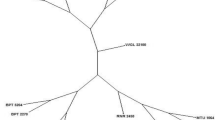Summary
Isozyme phenotypes at four known genetic loci were determined in parental inbreds and corresponding F1 hybrid seed lots of four commercial broccoli, two cauliflower, and two cabbage varieties to determine seed purity. Most inbred lines were completely homozygous at all four loci but differed with respect to alleles at one to three loci. Several parental inbreds of the cabbage hybrids were segregating at two to three of the loci. Models were developed to estimate seed purity in cases where parents were either fixed or segregating at diagnostic loci. Estimates of contamination ranged from 1.5 to 40.1%. These estimates were comparable with those from commercial grow-outs with a tendency for the former estimates to be higher. It was concluded that more stable SI alleles or genetic male sterility should be used to reduce contamination. Electrophoretic variation was further discussed as a tool for selecting homozygous plants and for strong self-incompatibility.
Similar content being viewed by others
References
Brewer, G. J., 1970. An introduction to isoenzyme techniques. Academic Press, New York.
Frankel, R. & Galun, E., 1977. Pollination mechanics, reproduction, and plant breeding. Springer-Verlag, Berlin, Heidelberg, and New York.
Gottlieb, L. D., 1981. Electrophoretic evidence and plant populations. Progress in Phytochemistry 7: 1–46.
Nijenhuis, B. Te., 1971. Estimation of inbred seed in brussels sprouts hybrid seed by acid phosphatase isoenzyme analysis. Euphytica 20: 498–507.
Rick, C. M., J. F. Holle, 1977. Genetic variation in Lycopersicon pimpinellifolium: evidence of evolutionary change in mating systems. Plant System. Evol. 127: 139–170.
Shaw, C. R. & A. L. Koen, 1968. Starch gel zone electrophoresis of enzymes. In: I. Smith (Ed.). Chromatographic and electrophoretic techniques. Vol. 2, Second Edition, John Wiley, New York.
Tanksley, S. D., 1979. Linkage, chromosomal association, and expression of Adh-1 and Pgm-2 in Tomato. Biochem. Genet. 17: 1159–1167.
Tanksley, S. D., 1980. Pgi-1 a single gene in tomato responsible for a variable number of isozymes. Can. J. Genet. Cytol. 22: 271.
Tanksley, S. D. & C. M. Rick, 1980. Prospects for the use of isozymes for legal purposes in tomato breeding. Rept. Tomato Genet. Coop. 30: 35–36.
Tanksley, S. D. & R. A. Jones, 1981. Application of alcohol dehydrogenase allozymes in testing the genetic purity of F1 hybrids of tomato. HortSci. 16 (2): 179–181.
Thompson, K. F., 1954. Breeding better kales. Agriculture (London) 65: 487–491.
Wills, A. B., S. K. Fyfe & E. M. Wiseman, 1979. Testing F1 hybrids of Brassica oleracea for sibs by seed isoenzyme analysis. Ann. Appl. Biol. 91: 263–70.
Wills, A. B. & E. M. Wiseman, 1980. Acid phosphatase isoenzymes of Brassica oleracea seedlings and their application to sib testing in F1 hybrids. Ann. Appl. Biol. 94: 137–142.
Woods, S. & D. A. Thurman, 1976. The use of seed acid phosphatases in the determination of the purity of F1 hybrid brussels sprout seed. Euphytica 25: 707–712.
Author information
Authors and Affiliations
Rights and permissions
About this article
Cite this article
Arús, P., Tanksley, S.D., Orton, T.J. et al. Electrophoretic variation as a tool for determining seed purity and for breeding hybrid varieties of Brassica oleracea . Euphytica 31, 417–428 (1982). https://doi.org/10.1007/BF00021659
Received:
Issue Date:
DOI: https://doi.org/10.1007/BF00021659




